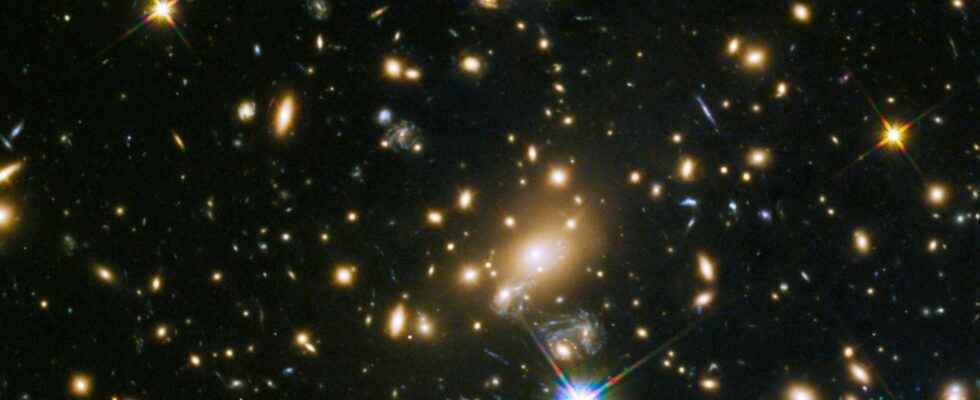Researchers have just discovered the galaxy farthest rotation ever observed. It crossed over 13.26 billion light-years before reaching us, and is called MACS1149-JD1, shortened to JD1. But what makes it special is its rotation speed : JD1 rotates much more slowly than rotating galaxies from a less ancient time. ” The rotation speed of JD1 is much slower than those found in galaxies of later epochs and our Galaxy and it is likely that JD1 is at an early stage of development of rotational motion,” explains Akio Inoue, co-author of a study published in the journal The Astrophysical Journal and professor at Waseda University.
The formation of the first galaxies, still mysterious today
There is still no consensus on the formation of the very first galaxies. The most accepted theory suggests that they were formed following the primordial fluctuations of densities, which are at the origin of the structure of the Universe. These fluctuations gave rise to dense zones, made up of both black matter and of gas. Gradually, this gas condensed, and this mass of matter grew: the very first galaxies were born during the reionizationcomposed only ofhydrogen and D’heliumthe lightest elements of the periodic table. The star formation only comes into play after the creation of these primordial galaxies. It is when a cloud of gas contained in the galaxy, called nebulacollapses on itself by gravitation only one star forms. In a galaxy, this process comes into play many times, first at the level of the center of the galaxy, where the majority of dust and gas is, then little by little this stellar formation is offset.
The setting in rotation develops from the first moments of the galaxies, when they are still only halos of matter. But it then accelerates, pushed by the formation of stars which accentuate the gravitational effects undergone on both sides of the galaxy. Thus, to determine the stage ofevolution of a galaxythem astronomers use the properties of the stars and the gases that compose them, such as their movement or their age. For these observations, they use the effect of gravitational lens : when a particularly massive object distorts the light of objects behind it in relation to the observer. This effect makes it possible to “grow up” certain objects that are too faint to be observed directly, by amplifying the light they emit. However, they appear distorted, forcing researchers to reconstruct them from the data collected.
JD1 makes it possible to date the late rotation of primordial galaxies
But the galaxy that interests us today is indeed JD1. Discovered by the Alma telescope (Atacama Large Millimeter/submillimeter Array), located in Chile, well designated for this, it was thanks to various observation campaigns carried out between October 2018 and December 2018, for a total of almost 10 hours of observation. To find out his age, the researchers measured thanks to Alma his red shiftalso called ” red shift “. It corresponds to the offset of the spectrum bright towards larger wavelengths when an object moves away from the observer. This is the doppler effectthe same one that changes the perception of the notes of the ambulance siren: the sound seems higher when it approaches (small wavelength), and lower when it moves away.
However, because of the expansion of the Universe, the older a galaxy, and therefore the more distant it is, the faster it moves away from us. With a particularly high spectral shift (z = 9.1), the researchers assigned it a stellar population a few hundred million years old, suggesting then an older epoch of formation, around z = 15. “Beyond the discovery of high redshift, i.e. very distant, galaxies, the study of their internal motion of gas and stars provides motivation to understand the process of galaxy formation in the most distant Universe. possible old »explains Professor Richard S. Ellis, co-author of the study and researcher at theUniversity College from London.
With a diameter of 3,000 light-years, compared to 100,000 for the Milky Way, it turns out, as the study explains, dominated by rotation, and not by dispersion: the dispersion of velocities is much lower than the rotational speed of the stars that make up the galaxy. This property allowed the team to model the dynamics of JD1, and to deduce other characteristics from it. In particular, the stars that compose it. It contains many mature stars, about 300 million years old, therefore formed more than 13.5 billion years ago. “This shows that the stellar population of JD1 formed at an even earlier time in the cosmic age,” explains Dr. Takuya Hashimoto, co-author of the study and researcher at the University of Tsukuba.
Reading ideas for the summer with Futura?
To celebrate the start of the holidays, we offer you the Mag Futura at the preferential price of 15 € instead of 19 €, i.e. a reduction of 20% !
What is Mag Futura?
- Our first paper journal of more than 200 pages to make science accessible to as many people as possible
- 4 major scientific questions for 2022, from the Earth to the Moon
- Home delivery*
*Special offer valid until July 19. Delivery is made in France (excluding metropolitan France), Switzerland, Belgium.
Interested in what you just read?
